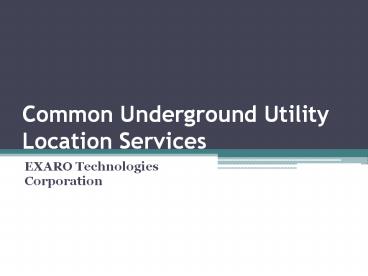Common Underground Utility Location Services - PowerPoint PPT Presentation
Title:
Common Underground Utility Location Services
Description:
Underground Utility Location Services Bay Area by Exaro Technology comply with the environment protocols while performing the task efficiently. Our experienced teams utilize the most advanced technology to ensure superior quality subsurface utility identification. – PowerPoint PPT presentation
Number of Views:150
Title: Common Underground Utility Location Services
1
Common Underground Utility Location Services
- EXARO Technologies Corporation
2
- During a construction project which involves
digging and excavating, it is critical to have
your utilities located before you dig. This will
help you save time budget, and also the cost of
dealing with a damaged utility. Looking broadly,
a damaged utility might pose hazards for the
environment too. Therefore, underground utility
location services are required. This article
discusses different methods available to locate
utilities. - Broadly speaking, the areas of focus within this
article are electromagnetic utility locating,
ground-penetrating radar, acoustic utility
locator, hydro excavation, and even dowsing.
3
Electromagnetic Utility Locating
- It is the most commonly used method to locate
private utilities. In electromagnetic underground
utility location service, the locators generate
an electromagnetic radio frequency. When applied
to the ground, the waves detect the underground
utilities containing conductive material on a
receiver. - This method is very popular for its accuracy to
detect a wide range of utilities including gas,
electricity, water, storm, telephone, irrigation,
cable, propane, and sewer lines. Electromagnetic
utility locator cannot, however, detect or locate
concrete, plastics, asbestos, terra-cotta, or
non-ductile pipes. - Gas lines are generally locatable because of the
material used in their manufacturing. Medium or
high-density polyethylene pipe, or plastic,
allows the locator to detect because commonly a
tracer wire runs alongside or on top of the
pipeline, making it easy to locate. With the help
of a tracer wire box or other system, a current
can be induced making it possible to locate the
tracer wire. - This technology works great in depth of 10-15
feet, whereas normally natural gas distribution
lines are installed within 4 feet underground.
Transmission lines are installed deeper than the
gas lines, but it rather unusual for any utility
line to be buried beyond a depth of 10 feet.
4
Ground Penetrating Radar
- GPR (Ground Penetrating Radar) is a technology
used for underground utility location services.
This technology is also based on high-frequency
pulses. A GPR emits radio waves into the ground,
which are deflected back by the facilities
subsurface. The deflected radio waves travel back
to the operator, and display the objects on the
equipment. - GPR is popular for locating buried utilities like
cables, pipes, manholes, tanks, and other buried
objects that cannot be located with other more
common methods, such as electromagnetic locating.
- There are certain limitations to this method of
underground utility location service. The biggest
challenge is that in order to operate a GPR
sufficient experience, training and expertise are
required, so that the results can be interpreted
accurately. Other than this some soils such as
saline, shale, or clay have high conductivity,
which limits the GPR from penetrating the soil.
Moreover, High-frequency GPR antennas offer a
limited penetration. Other factors which affect
GPRs effectiveness include soil density,
environment accessibility, and crowding of
surrounding utilities.
5
Hydro or Vacuum Excavation (potholing)
- While other utility locators require digging,
vacuum excavation, also known as potholing, is
non-destructive way to safely locate and expose
underground utilities. It is comparatively fast
as well. In this underground utility location
service, high-pressure air is used to break up
the soil, which is then sucked into a tank. This
method is perfect for excavating in difficult
soil conditions. Vacuum excavation also goes by
names hydro-digging, hydro-trenching, or soft
digging.
6
Dowsing
- Although dowsing is not recognized as an
efficient locator service for larger utilities,
but it considered as one the most reliable ways
to locate underground utilities and water by many
experienced locators. With one drawback of
inability to indicate the depth of a utility
underground, dowsing rods can indicate accurately
if you are standing on top of an active pipeline.
Dowsing can be made from coat hangers, and many
experienced locators find it a reliable way to
locate pipelines. Many skeptics claim this method
is based on intuition, and there is no science
working behind this method. Whatever the beliefs
various groups of people hold, the fact remains
that dowsing has been used as a reliable method
to detect underground water since the Middle Ages.
7
EXARO Technologies Corporation
- Underground Utility Location Services Bay Area by
Exaro Technology CO comply with the environment
protocols while performing the task efficiently.
Our experienced teams utilize the most advanced
technology to ensure superior quality subsurface
utility identification. To know more about our
services, get in touch with one of our
representatives today or visit our website.
8
THANK YOU

